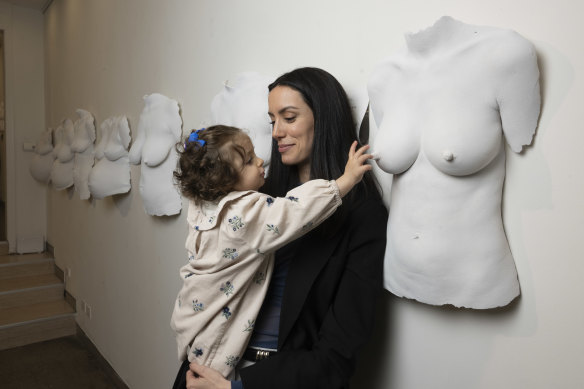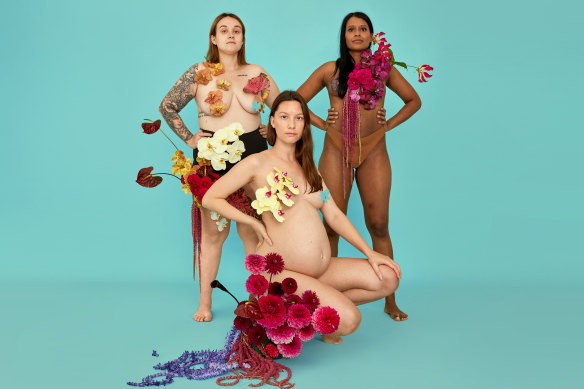The women trying to end the censorship of postpartum bodies
In recent years, the pregnant figure has been in the spotlight thanks to the bump-baring fashions of celebrities such as Rihanna and Sienna Miller. But the bodies of women after giving birth have yet to experience the same image shift.
“Pregnancy is celebrated, but this isn’t so much the case for mothers postpartum,” says Amelie Cazzulino, mum to 16-month-old Gabrielle and founder of postpartum care brand Bare Mum.

Amelie Cazzulino’s breastfeeding daughter, Gabrielle reaches towards a cast of her mother in the exhibition The Wall of Wombs by artist Juliana Monteiro.Credit: Janie Barrett
Cazzulino, 34, is speaking on a panel at the opening of The Wall of Wombs, an exhibition highlighting the diverse pathways to motherhood through a series of works created by Sydney-based artist Juliana Monteiro. A cast of Cazzulino’s torso, taken six months postpartum, is featured alongside those of 23 other mothers taken at varying stages – from 13 weeks pregnant all the way through to nine years postpartum. Each cast is accompanied by audio recordings of mothers recounting their unique experiences.
Cazzulino welcomes the celebration of pregnancy via celebrities, but says, “when it comes to postpartum, it’s about quickly putting it away and pretending that it never happened”.
She’s hopeful the exhibition challenges preconceptions about motherhood and bodies at a time when they are often rendered invisible.
“We often hear from women who don’t know you still have a tummy after birth. I think there’s still a huge emphasis on bouncing back,” she says.
“This is why you see products like belly bands being bestsellers, but the reality is they’re basically corsets. They don’t do you any good as they put downward pressure on your pelvic floor muscles.”
But she says progress is being made in the industry. “There are also businesses trying to move the dial and the conversation, which is fantastic.”
In the media, images of such bodies are often literally erased. Cazzulino explains posts depicting postpartum bodies are frequently removed by Meta from Bare Mum’s social media accounts as they are flagged as “sexual content”.
“We recently put up an educational post of a midwife giving latching tips for women who have gone through a C-section birth. That was demonstrated on a crocheted breast, and it was deemed to be sexual content [by Meta]. So it makes our job of trying to make educational content available to women so much more difficult.”
Last year, the brand’s Mother’s Day campaign, which featured pregnant and postpartum women’s nude bodies covered in flowers, was also removed after being posted on Instagram.
“We weren’t violating any of their guidelines. The images weren’t showing any breast or anything. But you could see postpartum bellies and stretch marks and scars. We wanted women to feel comfortable in their own skin by seeing that this is what other women look like as well.”
While the removal was eventually reversed, Cazzulino says the dispute process was lengthy and shouldn’t have had to happen in the first place.
“It is sad to see that in 2024 when we try to champion real postpartum bodies, we get censored,” says Cazzulino.

Images from Bare Mum’s Mother’s Day campaign last year were initially removed by Meta.Credit: Soul Studio, Yan Martea, Angela Dunne.
Cazzulino’s path to motherhood was not linear, and took an immense mental and physical toll. At 29, she was diagnosed with endometrial polyps and a breast hamartoma, which meant several taxing surgeries and the possibility she would not be able to conceive.
She says it took time to recover from her multiple surgeries and feel comfortable enough with her physical self again.
“The expectation is for you to be ready to become intimate again pretty much instantly. And that’s just not the case. After going through these surgeries, I was told, ‘Well, this is your fertile window. You should really try as soon as possible.’ And the reality is that it took me quite a while to feel like myself again to even be able to think about that.”
‘I was still shocked at my initial focus on what I saw as flaws’
Marie, a 34-year-old creative based in Sydney, had her daughter in October last year through IVF after four years of trying, during which she lost her first child.
Marie, who is using a pseudonym for privacy reasons, says the process of becoming a mother was “continually trying”.
“Whilst I outwardly worked, studied and appeared to function in the world, privately those years overflowed with heartache. I cried often, mostly after opening social media and seeing pregnancy announcements.”
Throughout her IVF journey, Marie found herself continually advocating for herself in the medical system based on intuition, which resulted in an endometriosis diagnosis.
“I have great respect for modern medicine and all the options we currently have in the fertility space. However, it is so hard to navigate what to do and when,” she says.
“There is a sense of constantly having to make big decisions, some hugely unaffordable, whilst living with the emotions and the unknowns of trying to fall pregnant. I felt reading and asking questions were the only actions I had control of in what felt like such an out-of-control journey.”
Marie’s cast was taken six months postpartum, with her daughter on the floor beside her – a process she says has helped her embrace her body.
“I have so much respect for my body and what it has been through these last few years, yet I was still shocked at my initial focus on what I saw as flaws, particularly in the shape of my belly,” she says.
“I think it’s important to acknowledge that our initial reactions aren’t always truth, and now I look at the cast and love it.”
‘I had no thoughts of bouncing back to my pre-pregnancy body’
For Brooke, a 25-year-old mum who has chosen to withhold her surname for privacy reasons, pregnancy was the first time she felt total love and appreciation for her body.
“When Indi was born, I had no thoughts to ‘try and bounce back’ to my pre-pregnancy body as
society likes to always comment on.”
Having been diagnosed with endometriosis at 21 after more than five years of pushing for a diagnosis, the feeling of being unseen was not unfamiliar to her.
She draws parallels between endometriosis, pregnancy and postpartum.
“When you have endometriosis and laparoscopy surgery, the diagnosis and recovery is very much overlooked [like postpartum]. I remember having surgery and being told to ‘get up slowly, eat a sandwich then I was good to go’ and it almost felt like a transaction, like they were trying to do as many day surgeries as they could.”
Having the casting done at 16 months postpartum, Brooke says, “came at a time when I needed it most”.
“I had just finished breastfeeding a few months prior so my body had changed so much. My boobs had shrunk and my hormones were everywhere.”
She says during the casting, “all the self-conscious and critical thoughts of myself disappeared. Seeing my body cast now from when I was 16 months postpartum, it’s a liberating feeling to take a moment to pause and reflect on each stage throughout this journey and see how far I’ve come.”
The Wall of Wombs is a free exhibition in Surry Hills, Sydney. Until June 10. For more information or to share your own story, click here.
Make the most of your health, relationships, fitness and nutrition with our Live Well newsletter. Get it in your inbox every Monday.